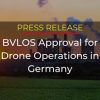2020 was a monumental year from start to finish. Kicking off with the devastating bushfires and ending with glimmering hopes of a vaccine – it was, to say the least, a roller coaster of events we’re all hoping to leave behind us. But before we do so, we’d like to reflect with you on what we learned from 2020, specifically in the fields we know best: autonomous technology and how to harness it for industrial facility inspections processes, monitoring, and data collection improving environmental monitoring.
This year, we learned first hand from our existing and new clients how critical it is to include autonomous technology in business continuity and disaster response plans. We also learned how quickly we, as a company, could adapt and push out new features and solutions to support our clients’ needs.
Before we get into what we learned from 2020, let’s take a look at some defining moments for us at Percepto during this past year:
1. Fully autonomous inspection and monitoring made a huge difference when it was needed most
2020 saw a lot of fast-paced digitalization, and we noticed a huge uptick in industrial facilities turning to autonomous robots to automate workflows. For example, at a major automotive manufacturing facility in Mexico, shuttered owing to pandemic restrictions, we massively shored up perimeter security when human teams were locked down. In Florida, our autonomous drones helped Florida Power and Light recover faster from hurricane damage to facilities and power lines, and in Washington state we helped Verizon inspect critical infrastructure that was inaccessible to humans owing to wildfires.
In Australia, Percepto autonomous drones were adopted by a major mining concern for real-time, remote stockpile monitoring, among other mission-critical tasks. And in the Middle East, our solutions continued to conduct fully-automated aerial inspection and monitoring of the massive ICL Dead Sea Works complex. Back in North America, DelekUS, a mid-stream oil refinery, adopted Percepto to automate visual inspections of tanks and equipment, detect leaks and temperature anomalies, conduct security patrols and provide emergency response.
2. Large-scale drone regulation change eases adoption of autonomous drones
2020 was a big year for drone regulation, with numerous breakthrough regulatory approvals worldwide. Percepto is leading the way in a massive, industry-wide regulatory shift which will enable autonomous technology across many sectors. We continued to work closely with regulators around the world, engaging in drone programs that are shaping the future of drone regulation – most notably the FAA’s type certificate program, where we join fellow industry leaders such as Amazon in reshaping drone regulation in the US. On the other side of the globe, we gained approval to fly extended visual line of sight (EVLOS) in Australia, with beyond line of sight (BVLOS) approval on the horizon. Verizon requested and received a first-of-its-kind BVLOS waiver from the FAA to operate Percepto drones remotely during the above-mentioned wildfire. Similar breakthrough approvals were obtained through close work with regulatory bodies in Israel, Australia and Europe.
3. Continuous product innovation
In addition to launching our new AIM platform in 2020, our team focused on numerous crucial product enhancements. Adapting to all climates, our Air Max (Sparrow) autonomous drones passed level 5 hurricane safety testing in Florida, and flew in a heavy snowstorm elsewhere in the US. We added crucial drone safety features that enable truly autonomous flights, including a unique ASTM 3322-18 standard compliant integral parachute.
2020 Takeaways: lessons learned
1. Include autonomous tech in your business continuity plans
This is a big takeaway for us and our clients. At this point, every company should have thought long and hard about what their business continuity plan looks like and how their company can adapt and survive in the face of serious disruptions. Our advice: include autonomous technology. For almost any unforeseen circumstance, autonomous technology could save your business. This year at industrial facilities sites, we saw our existing clients bounce back quickly after the pandemic hit. Those that hadn’t already taken the plunge into digitalization and autonomous tech experienced some serious growing pains while adjusting to life without employees on site.
2. Keep employees safe with autonomous robots
In addition to autonomous tech helping businesses bounce back from COVID-19, we saw autonomous robots – especially autonomous drones – come to the rescue yet again for emergency response. Most of us have heard of autonomous drones responding to events from hurricanes, to earthquakes and forest fires. Yet, autonomous robots also play a critical role in keeping employees safe at industrial facilities on a daily basis – they can easily perform dangerous inspections, tasks with hazardous materials, risky security patrols, and more.
3. Develop regional partners
We saw most, if not all, businesses come to a halt in some way or another due to new logistical restrictions associated with the pandemic. We felt lucky to be an international company with support around the globe. With HQ in North America, Australia, and Israel, and with partners all over the world, we supported our clients throughout 2020 with new deployments, technical support, new features, and expanded use cases.
There’s no question that 2020 has been a challenging year for everyone. Yet autonomous robotics – much like the people that this innovative technology was designed to serve – has truly risen to meet these challenges.





